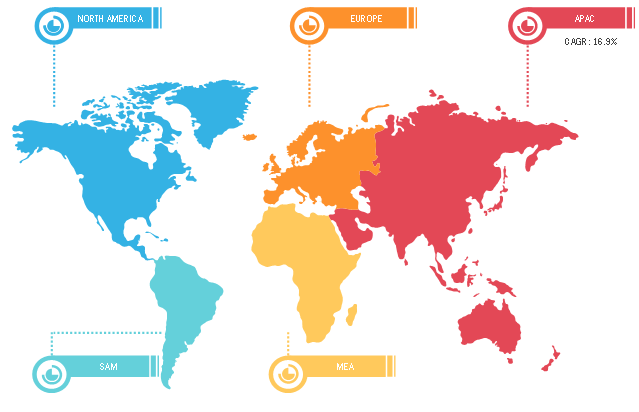Growing Demand for Biocomposites from Automotive Industry to Escalate Biocomposites Market Growth During 2022–2028
According to our latest market study on "Biocomposites Market Forecast to 2028 – COVID-19 Impact and Global Analysis – by Fiber (Wood Fiber Composite and Non-Wood Fiber Composite), Product (Hybrid Composite and Green Composite), and End-Use Industry (Building & Construction, Automotive, Consumer Goods, and Others),” the market is expected to grow from US$ 19,268.62 million in 2022 to US$ 46,851.39 million by 2028; it is estimated to grow at a CAGR of 16% from 2022 to 2028. The report highlights key factors driving the market growth and prominent players with their progress in the market.
Biocomposite is a material formed by a matrix and a reinforcement of natural fibers, including wood, hemp, flax, jute, and sisal. The matrix material present in biocomposites can be biodegradable, nonbiodegradable, or synthetic. Synthetic matrix materials, along with natural fibers, are used to form hybrid biocomposites.
In recent years, there has been a growing demand for lightweight materials from the automotive industry to meet the required performance standards for fuel economy. Biocomposites are increasingly used in the industry as it reduces vehicle weight, which helps in improving vehicle performance and lowering CO2 emissions. According to the European Union (EU) Commission, on a yearly basis, the European automotive industry consumes 80,000 metric ton of plant and wood fibers to reinforce composite products instead of other synthetic fibers. The European Union (EU) has also emphasized using recyclable and biodegradable parts for automotive interior components. Biocomposites have better acoustic and thermal properties than the composites of nonrenewable origin, making them an ideal material to be used for manufacturing interior parts of a vehicle. Various properties of biocomposites make them suitable for the manufacture of nonstructural interior components, including seat fillers, seat backs, headliners, interior panels, and dashboards.
TTS, Lingrove, Bcomp Ltd., UPM, Flexform Technologies, Tecnaro Gmbh, Green Bay Decking, Fiberon LLC, Arkema, and Procotex are among the well-established players constituting the majority of the biocomposites market share.
Impact of COVID-19 Pandemic on Biocomposites Market
The COVID-19 pandemic adversely affected the chemicals & materials industry owing to the shutdown of manufacturing facilities, difficulty in procuring raw materials and components, and restrictions on logistic operations. The disruptions in the supply of raw materials to manufacturers hampered biocomposites production. The outbreak distorted operational efficiency and hindered the value chains due to the sudden shutdown of national and international boundaries, creating revenue loss and damage. Various biocomposites manufacturers had to temporarily close their operations or limit their production capacities, which negatively impacted the biocomposites market. The fall in demand due to the negative impact of the COVID-19 pandemic on the manufacturing of vehicles has restrained the biocomposites market. However, the businesses are gaining ground as governments of various countries across the world have eased out the previously imposed restrictions. The start of operations in the biocomposites manufacturing units is positively impacting the market development.
Biocomposites Market Size, by Region, 2021–2028

Biocomposites Market Size, Share, Growth & Scope | Analysis 2028
Download Free Sample
Biocomposites Market Size and Forecasts (2022 - 2028), Global and Regional Growth Opportunity Analysis By Fiber (Wood Fiber Composite and Non-Wood Fiber Composite); Product (Hybrid Biocomposite and Green Biocomposite), End Use(Building and Construction, Automotive, Consumer Goods, and Others), and Geography
Biocomposites Market Size, Share, Growth & Scope | Analysis 2028
Download Free SampleBiocomposites Market Size and Forecasts (2022 - 2028), Global and Regional Growth Opportunity Analysis By Fiber (Wood Fiber Composite and Non-Wood Fiber Composite); Product (Hybrid Biocomposite and Green Biocomposite), End Use(Building and Construction, Automotive, Consumer Goods, and Others), and Geography
The "Global Biocomposites Market Analysis to 2028" is a specialized and in-depth study of the chemicals and materials industry with a special focus on the global biocomposites market trend analysis. The report aims to provide an overview of the market with detailed market segmentation. The biocomposites market is segmented on the basis of fiber, product, end-use industry, and geography. Based on fiber, the market is bifurcated into wood fiber composites and non-wood fiber composites. In terms of product, the market is segmented into hybrid biocomposites and green biocomposites. Based on the end-use industry, the biocomposites market is segmented into building & construction, automotive, consumer goods, and others. Based on geography, the market is segmented into North America, Europe, Asia Pacific, the Middle East & Africa, and South & Central America. Asia Pacific dominated the biocomposites market in 2021 and is expected to be the fastest-growing region during the forecast period. The countries in the Asia Pacific are emerging markets for biocomposites owing to the growing end-use industries, including building and construction, automotive, and consumer goods. The increased use of sustainable materials in the construction industry is driving the biocomposites market. In addition, an increase in automotive production in countries such as China and India propel the demand for biocomposites from the automotive industry across the region.
Contact Us
Phone: +1-646-491-9876
Email Id: sales@theinsightpartners.com